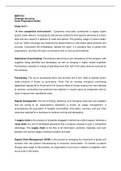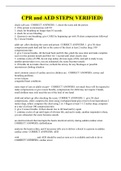MNP3701
Strategic Sourcing
Exam Preparation Notes
Study Unit 1
“A new competitive environment”: Customers have been conditioned to expect higher
quality, faster delivery, and products and services tailored to their specific demands at a lower
total cost as a result of a plethora of rivals and options. The growing usage of "social media"
such as Twitter and blogs has hastened the dissemination of information about products and
services. Consumers will immediately "spread the news" if a company fails to satisfy their
expectations, and they will seek out someone who is more accommodating.
Importance of purchasing: Purchasing is becoming a core competency of the company, with
suppliers being identified and developed, as well as bringing in highly valued expertise.
Purchasing is typically in charge of spending more than half of the sales revenue received by
the company.
Purchasing: The act of purchasing items and services that a firm need to operate and/or
make products is known as purchasing. Given that an average company's purchasing
department spends 50 to 70 percent of its revenue Rand on things ranging from raw materials
to services, purchasing has received more attention in recent years as companies look for
ways to reduce their operational costs.
Supply management: The act of finding, obtaining, and managing resources and suppliers
that are critical to an organization's operations is known as supply management. It
encompasses the acquisition of tangible commodities, information, services, and any other
resources required for a business to continue running and developing.
A supply chain is the process of all parties engaged in delivering a client request, whereas a
value chain is a set of interrelated operations that a company employs to gain a competitive
advantage. The supply chain is the flow of all information, products, materials, and cash
between the various stages of product creation and sale.
Supply Chain Management (SCM): is the process of managing the movement of goods and
services from raw product manufacturing to consumer consumption. To transfer a product
through each stage of this process, an organization must have a network of suppliers (who
act as links in the chain).
,Supply chain management (SCM): is the proactive management of supply chain activities
in order to optimize customer value and achieve long-term competitive advantage. It signifies
a concerted effort by supply chain organizations to create and operate supply chains in the
most effective and efficient manner feasible. Product creation, sourcing, production, and
logistics, as well as the information systems required to coordinate these activities, are all
covered by supply chain activities.
The extended value chain or extended business concept, which asserts that success is a
function of efficiently managing a linked network of firms beyond first-level suppliers or
customers, is built on many levels of suppliers and customers. In reality, forward-thinking
companies recognize that controlling costs, quality, and delivery necessitates paying attention
to suppliers several tiers down the supply chain. The extended enterprise idea recognizes that
competition is now between coordinated supply chains or networks of enterprises, rather than
between firms.
Explain how an organisation can achieve purchasing and supply chain benefits.
a) Increasing value and savings
Many firms are shifting their attention to purchasing and supply management as they
attempt to boost customer value by improving performance.
b) Building relationship and driving innovation
To make these partnerships work, both the customer and the supplier must agree on
acceptable paybacks from their investments, ensuring that both parties’ profit. If the
suppliers' strategic goal is to be the buyer's preferred vendor, they must supply the
appropriate technical infrastructure.
c) Improving quality and reputation
The quality of products and services is also influenced by purchasing and supply
management. Many businesses are attempting to increase the proportion of parts,
components, and services they outsource in order to focus on their core competencies
and specializations. The importance of partnerships between purchasing, external
suppliers, and quality is heightened as a result.
d) Reducing Time to Market
Purchasing can also assist in the improvement of product and process designs by
acting as a link between suppliers and engineers. Organizations that incorporate
, suppliers early, on average, get a 20% reduction in material costs, material quality,
and product development times as compared to companies that do not involve
suppliers early.
e) Generating economic impact
Economies of scale refer to a company's cost advantage as its output grows. Because
of the inverse relationship between per-unit fixed cost and amount generated, the
benefit arises. The smaller the per-unit fixed cost, the bigger the quantity of output
generated. With an increase in output, economies of scale also result in a decrease in
average variable costs (average non-fixed expenses). Operational efficiencies and
synergies as a result of increased manufacturing scale are responsible for this.
f) Contributing to competitive advantage
Focusing on efficient purchasing has become a crucial approach to achieve a
competitive edge. The greater pay offered to purchasing experts as a result of the
competitive advantage they bring to an organization are an evidence of this elevated
prestige, reputation, and recognition.
List the activities that are part of the supply chain umbrella.
Supply chain management encompasses a wide range of tasks in addition to purchasing.
Each of these seemingly disparate tasks has one thing in common: they are all connected to
a network that determines how efficiently and effectively goods and information flow
throughout a supply chain. Although the necessity for supply chain-related operations has
been for a long time, the willingness of an organization to align, coordinate, integrate, and
synchronize these activities and flows is relatively new.
a) Inbound transportation
To manage the physical and informational ties between the supplier and the buyer,
larger firms typically have a specialist traffic and transportation role. Transportation is
the single largest category of single costs for certain firms, particularly very diverse
organizations. Although a company's operating units may have few common
procurement requirements, there are usually opportunities to coordinate the purchase
of transportation services.
, b) Quality Control
In the last fifteen years, quality control has been increasingly important. Almost every
company understands the value of supplier quality and the necessity to prevent rather
than just discover quality issues. The focus has changed away from finding faults after
delivery or usage and toward prevention early in the materials sourcing process. To
build proper quality control procedures and processes, progressive firms collaborate
directly with suppliers.
c) Demand and Supply planning
Demand planning is the process of identifying all claims (or demand) on output.
Forecasted demand, inventory revisions, orders taken but not met, and spare-part and
aftermarket requirements are all part of this. The process of taking demand data and
building a supply, production, and logistics network capable of meeting demand
requirements is known as supply planning.
d) Receiving, materials handling and storage
As it flows from a supplier to a purchaser, all inbound material must be physically
received. Material must also be kept or staged in a non-just-in-time setting. Because
of the requirement to control the physical processing and handling of inventories,
receiving, materials handling, and storage are typically part of the materials
management function. Receipts from users showing the completion of services are
likewise routed through receiving to trigger invoice payment.
e) Materials or inventory control
The materials control group is frequently in charge of estimating the correct quantity to
order based on predicted demand and then controlling material releases to suppliers.
The inventory control group is frequently in charge of establishing the level of finished
items required to meet customer demands, emphasizing the physical distribution (i.e.,
outbound or downstream) side of the supply chain. To maintain a seamless and
uninterrupted flow to customers, integrated supply chain management needs the
materials and inventory control departments to coordinate their efforts.
f) Order processing
Customers obtain material when and where they need it thanks to order processing.
Accepting orders before establishing if appropriate production capacity is available,
not synchronizing order processing with order scheduling, and scheduling orders using
internal production dates rather than the customer's preferred date have all been











